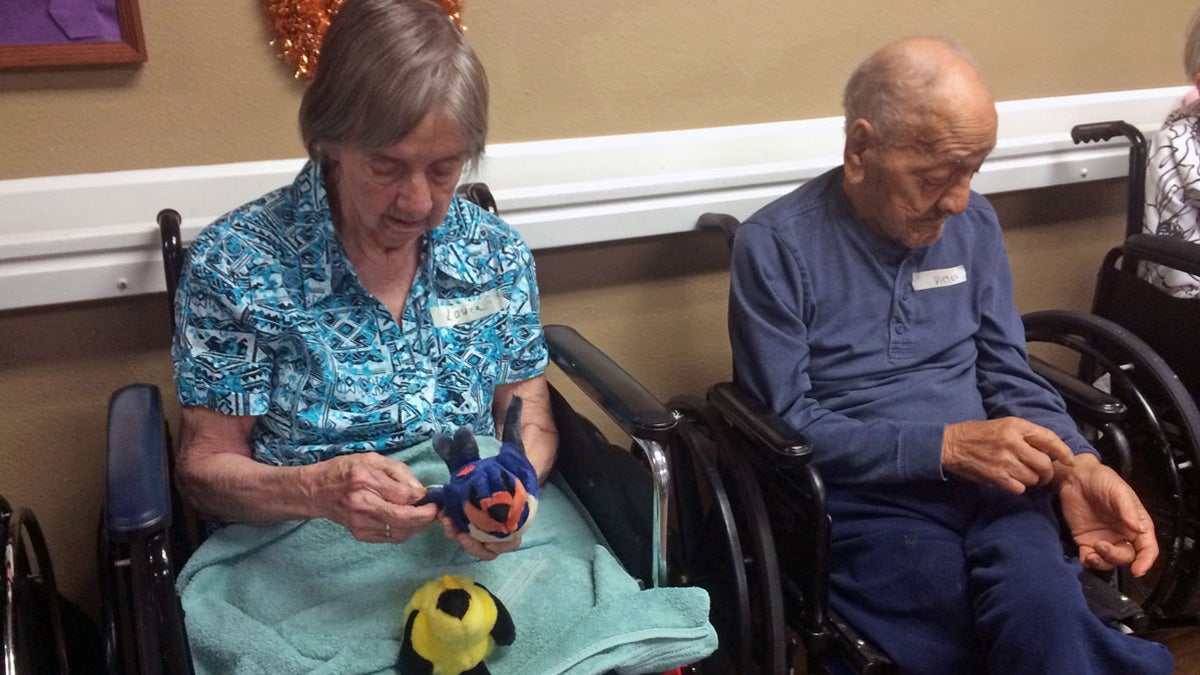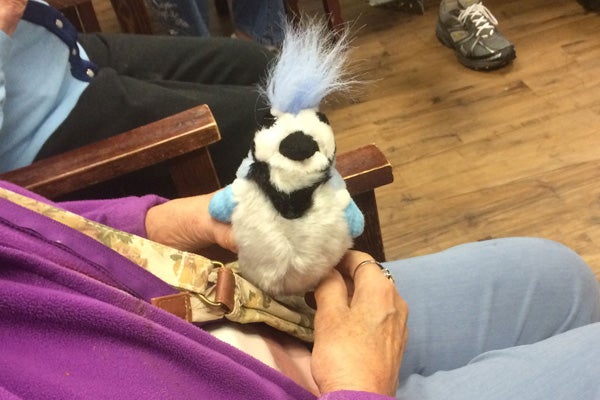A unique approach to dementia therapy: bird songs
Listen
Residents at the Northglenn Heights long term care facility play with plush bird stuffed animals that make real bird calls. (Stephanie Paige Ogburn/for WHYY)
Scientists are investigating what happens when you bring nature into nursing homes.
The Northglenn Heights long-term care facility sits in suburbs of North Denver. The building looks nice from the outside, but not particularly unique. The inside is pretty standard, too—linoleum floors, fluorescent lights, handmade posters celebrating an upcoming holiday or event.
So it’s a little surprising to learn that inside a small community room, once every two weeks, a very unique activity takes place.
On a weekday morning, residents sit in circle, some in wheelchairs and others with walkers at the ready. Volunteer Dale Jones walks slowly around the circle. He’s handing out small, plush toy birds that fit neatly in their hands. The stuffed animals are loosely modeled after bird species—blue jays, finches, robins, and other types of birds. As he walks around, Jones gives instructions.
“You can just hold onto it, and if you want to listen to it sing, press right here in the middle,” he says.
As the residents grasp how the birds work, they start pressing them, and the sound of recorded bird songs fills the room. If you close your eyes, you could easily think you were in a forest in spring.
“It squeaks, it squeaks! I’ve never seen that before,” one resident exclaimed.

It may seem a little strange, but these plush birds are part of a therapeutic educational program for adults with dementia. Called Bird Tales, it’s run through the Bird Conservancy of the Rockies, a local conservation group.
Tyler Edmonson is an educator with the Conservancy and is leading today’s class. It’s about feathers, he tells the circle of residents.
“We actually brought some really amazing feathers from real birds today for you to feel and look at.”Edmonson passes around the feathers and gives each resident a chance to participate. He bends down to chat with Chuck, an adult who suffers from dementia.
“Chuck, we have your house finch down on the ground with really amazing red feathers. What colors do you see on your bird?”
Chuck isn’t certain how to respond. He stammers a little, then volunteers a fact about his bird.”It’s…it’s…it’s real flat.”
Even though Chuck struggles to find the works to express himself, he’s looks like he’s enjoying the class. He holds his bird, presses it to make it chirp, and participates with the few words that come to his mind.
Some of the residents are less alert, and a few even appear asleep, but Edmonson speaks directly to everyone in the room, even those that are nonverbal. He touches feathers to their skin, and gives them birds to hold. Even if they don’t appear to respond, the therapy could touch them in an unforeseen way, he said.
“We want to make sure they have a chance to have a response even if we can’t discern it or see it.”
Northglenn Heights activities director Gabriella Dimotsantos says she was a little skeptical of the program at first. She is fairly new to this long-term care facility, and had never heard of any therapy like this.
Then she saw how it calmed residents and improved their moods. Take Chuck, the resident who called his bird flat. He’s typically irritable and difficult to work with. Dimotsantos says there are just two things that calm him down: “Krispy Kreme, and Bird Tales would brighten his day anytime,” she laughs.
Dimotsantos believes one reason for the program’s success is it works on many levels.
“What’s really nice about Bird Tales is it captures many different senses. You have visual, you have the physical touch, you hear the sound of the birds.”
After a Bird Tales program, Dimotsantos says residents are usually in a better mood for a few hours, maybe even the rest of the day. They may not remember why, but they do seem more peaceful, she said.
Bird Tales was developed in 2011 by Audubon Society educator Ken Elkins and memory care specialist Randy Griffin, at an Audubon Society in Connecticut. It’s in a few facilities there, and there are now a couple programs in memory care units in Colorado and Texas.
It’s not completely clear why dementia patients respond to it so well. But its connection to nature may be one reason, said Jennifer Dibert, a gerontologist who analyzed Bird Tales as part of her masters research at Miami University in Oxford, Ohio.
“So there’s not a ton of research about nature based programs and people with dementia. It’s something we’re just now starting to look at,” she said.
While there isn’t much known about the role nature exposure plays in patients with dementia, there has been research on nature’s impacts on people more generally. In those studies, psychologists and epidemiologists have shown exposure to nature can improve some aspects of health, said Dibert.
“It really reduces stress, improves your mood, reduces depression, anger, anxiety. It enhances your feelings of pleasure.”
At Northglenn Heights, the 45 minutes of Bird Tales is coming to an close. Tyler Edmonson asks the residents to use their birds one last time.
“What we’d love for you to have them do is have them sing all together see if we can create a chorus.”
The sound of singing birds once again fills the room. Then, says Edmonson, it’s time to return the birds to their nest. Not everyone wants to give theirs up. But Edmonson tells them that’s okay; he and his birds will be back again in just a couple weeks.
WHYY is your source for fact-based, in-depth journalism and information. As a nonprofit organization, we rely on financial support from readers like you. Please give today.



